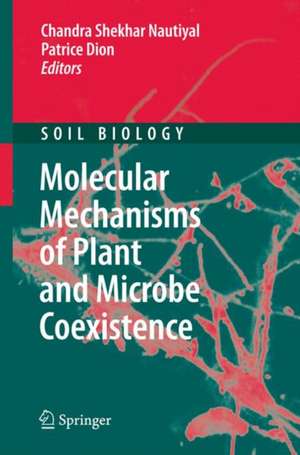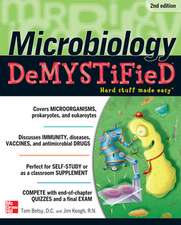Molecular Mechanisms of Plant and Microbe Coexistence: Soil Biology, cartea 15
Editat de Chandra Shekhar Nautiyal Cuvânt înainte de V. L. Chopra Editat de Patrice Dionen Limba Engleză Hardback – iul 2008
The role of soil microbial diversity in enhancing plant health and plant microbe beneficial symbioses is discussed. Microbial communities are shown in the light of evolution. Main topics include genome coexistence and the functional genomics and proteomics of plant-associated microbes, which could form the basis for new environmentally benign strategies to combat infectious plant diseases and regulate plant growth. Further chapters focus on the role of signaling during the different stages of plant microbe coexistence, in symbiotic or pathogenic relationships, in quorum sensing and plant viral infections. Methods for studying the interactions in the root zone complement the book, which will certainly be of relevance in the practical application to agriculture, food security and for maintaining the balance of our ecosystems.
| Toate formatele și edițiile | Preț | Express |
|---|---|---|
| Paperback (1) | 1226.60 lei 6-8 săpt. | |
| Springer Berlin, Heidelberg – 30 noi 2010 | 1226.60 lei 6-8 săpt. | |
| Hardback (1) | 1231.32 lei 6-8 săpt. | |
| Springer Berlin, Heidelberg – iul 2008 | 1231.32 lei 6-8 săpt. |
Din seria Soil Biology
- 18%
 Preț: 958.56 lei
Preț: 958.56 lei - 18%
 Preț: 1225.62 lei
Preț: 1225.62 lei - 18%
 Preț: 957.75 lei
Preț: 957.75 lei - 18%
 Preț: 1232.09 lei
Preț: 1232.09 lei - 18%
 Preț: 949.90 lei
Preț: 949.90 lei - 18%
 Preț: 1392.95 lei
Preț: 1392.95 lei - 18%
 Preț: 952.26 lei
Preț: 952.26 lei - 18%
 Preț: 956.03 lei
Preț: 956.03 lei - 18%
 Preț: 948.29 lei
Preț: 948.29 lei - 18%
 Preț: 1224.18 lei
Preț: 1224.18 lei - 18%
 Preț: 1226.90 lei
Preț: 1226.90 lei - 18%
 Preț: 952.26 lei
Preț: 952.26 lei - 18%
 Preț: 942.63 lei
Preț: 942.63 lei - 18%
 Preț: 946.55 lei
Preț: 946.55 lei - 18%
 Preț: 1221.20 lei
Preț: 1221.20 lei - 18%
 Preț: 1225.94 lei
Preț: 1225.94 lei - 18%
 Preț: 946.24 lei
Preț: 946.24 lei - 24%
 Preț: 1051.29 lei
Preț: 1051.29 lei - 18%
 Preț: 1221.02 lei
Preț: 1221.02 lei - 18%
 Preț: 947.98 lei
Preț: 947.98 lei - 18%
 Preț: 948.47 lei
Preț: 948.47 lei - 18%
 Preț: 1222.31 lei
Preț: 1222.31 lei - 18%
 Preț: 1231.64 lei
Preț: 1231.64 lei - 18%
 Preț: 1225.31 lei
Preț: 1225.31 lei - 18%
 Preț: 1229.73 lei
Preț: 1229.73 lei
Preț: 1231.32 lei
Preț vechi: 1501.62 lei
-18% Nou
Puncte Express: 1847
Preț estimativ în valută:
235.64€ • 255.87$ • 197.94£
235.64€ • 255.87$ • 197.94£
Carte tipărită la comandă
Livrare economică 22 aprilie-06 mai
Preluare comenzi: 021 569.72.76
Specificații
ISBN-13: 9783540755746
ISBN-10: 3540755748
Pagini: 504
Ilustrații: X, 486 p.
Dimensiuni: 155 x 235 x 31 mm
Greutate: 0.84 kg
Ediția:2008
Editura: Springer Berlin, Heidelberg
Colecția Springer
Seria Soil Biology
Locul publicării:Berlin, Heidelberg, Germany
ISBN-10: 3540755748
Pagini: 504
Ilustrații: X, 486 p.
Dimensiuni: 155 x 235 x 31 mm
Greutate: 0.84 kg
Ediția:2008
Editura: Springer Berlin, Heidelberg
Colecția Springer
Seria Soil Biology
Locul publicării:Berlin, Heidelberg, Germany
Public țintă
ResearchCuprins
Coexistence Between Populations.- Plant Associated Soil Micro-organisms.- Role of Microbial Diversity for Soil, Health and Plant Nutrition.- Reconstructing Soil Biology.- Rhizosphere Colonization: Molecular Determinants from Plant-Microbe Coexistence Perspective.- Belowground Mycorrhizal Endosymbiosis and Aboveground Insects: Can Multilevel Interactions be Exploited for a Sustainable Control of Pests?.- Coexistence Between Genomes.- Evolutionary Genomics: Linking Macromolecular Structure, Genomes and Biological Networks.- Evolutionary Genomics of the Nitrogen-Fixing Symbiotic Bacteria.- Genetic and Epigenetic Nature of Transgenerational Changes in Pathogen Exposed Plants.- Recent Advances in Functional Genomics and Proteomics of Plant Associated Microbes.- Molecular Mechanisms of Biocontrol by Trichoderma spp..- Coexistence Between Molecules.- Quorum Sensing in Bacteria-Plant Interactions.- Signals in the Underground: Microbial Signaling and Plant Productivity.- Protein-Protein Interactions in Plant Virus Movement and Pathogenicity.- Effects of Root Exudates in Microbial Diversity and Activity in Rhizosphere Soils.- Methods to Study Plant and Microbe Coexistence.- Siderotyping, a Straightforward Tool to Identify Soil and Plant-Related Pseudomonads.- Molecular Strategies for Identifying Determinants of Oomycete Pathogenicity.- Molecular Methods for Studying Microbial Ecology in the Soil and Rhizosphere.- Morphotyping and Molecular Methods to Characterize Ectomycorrhizal Roots and Hyphae in Soil.
Textul de pe ultima copertă
Molecular Mechanisms of Plant and Microbe Coexistence presents studies on the complex and manifold interactions of plants and microbes at the population, genomics and proteomics level.
The role of soil microbial diversity in enhancing plant health and plant microbe beneficial symbioses is discussed. Microbial communities are shown in the light of evolution. Main topics include genome coexistence and the functional genomics and proteomics of plant-associated microbes, which could form the basis for new environmentally benign strategies to combat infectious plant diseases and regulate plant growth. Further chapters focus on the role of signaling during the different stages of plant microbe coexistence, in symbiotic or pathogenic relationships, in quorum sensing and plant viral infections. Methods for studying the interactions in the root zone complement the book, which will certainly be of relevance in the practical application to agriculture, food security and for maintaining the balance of our ecosystems.
The role of soil microbial diversity in enhancing plant health and plant microbe beneficial symbioses is discussed. Microbial communities are shown in the light of evolution. Main topics include genome coexistence and the functional genomics and proteomics of plant-associated microbes, which could form the basis for new environmentally benign strategies to combat infectious plant diseases and regulate plant growth. Further chapters focus on the role of signaling during the different stages of plant microbe coexistence, in symbiotic or pathogenic relationships, in quorum sensing and plant viral infections. Methods for studying the interactions in the root zone complement the book, which will certainly be of relevance in the practical application to agriculture, food security and for maintaining the balance of our ecosystems.
Caracteristici
Includes supplementary material: sn.pub/extras









